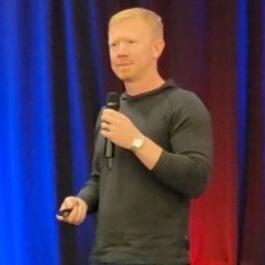
Deep Listening - Impact beyond words - Oscar Trimboli
The world is a noisy place where you fight to be heard every day. Despite the fact that we have been taught at home and at school how to speak, none of us has had any training in how to listen. Multiple academic studies have shown that between 50% and 55% of your working day is spent listening, yet only 2% of people have been trained in how to listen. We feel frustrated, isolated and confused because we aren't heard. As a speaker, it takes absolutely no training to notice when someone isn't listening - they're distracted, they interrupt or drift away as you talk. Yet the opposite is also true, without any training in how to listen we struggle to stay connected with the speaker and the discussion. This results in unproductive workplaces where people fight to be heard and need to repeat themselves constantly, send emails to confirm what they said and then have follow-up meetings to ensure what was said was actually heard by those in the meeting. It's a downward spiral that drains energy from every conversation and reduces the productivity of organisations. This podcast is about creating practical tips and techniques to improve your daily listening. Listen for free
Show episodes
Claire Pedrick, Shaney Crawford and Oscar Trimboli explore the nuances and dynamics of workplace listening, including the importance of presence, flexibility, and curiosity. Key insights include: Listening is about creating shared meaning, not just exchanging information. Meaning only emerges in a collaborative space.
In the previous episode 127, Claire Pedrick and I discussed listening through many dimensions, including the role of pause and silence, the influence of the backstory and its impact on workplace change. Now we are at Part Two of Three, you're about to hear is the reflections from 16 different listeners who initially em
What emerges in between? This episode is an 'experiment' between Claire Pedrick and Oscar Trimboli as a result of an introduction by Shaney Crawford from Japan. They explore the role of second languages, the value of silence, and the importance of understanding the past. What does a group listening audit sound and look
This episode delves into the critical role of listening, particularly in the context of debates and the competitive advantage provided to participants. Sasan Kisravi explains the significance of preparation in debate, especially when preparing both sides of the argument. When preparing both sides of an argument, you ca
The importance of listening at Level II, which is three-dimensional hear, see, and sense Noticing nonverbal cues and their congruence with their words is a vital skill toward becoming a deeper listener. While these cues can be informative, it's crucial to interpret them accurately and consider the context. During this
Insights from 33,519 people about what gets in their way of listening and practical tips about what will imrpove your listening. An update on the fourth generation www.listeningquiz.com including; aggregate listening profiles for more than 10 people cross-industry benchmarking administration features to track progress



